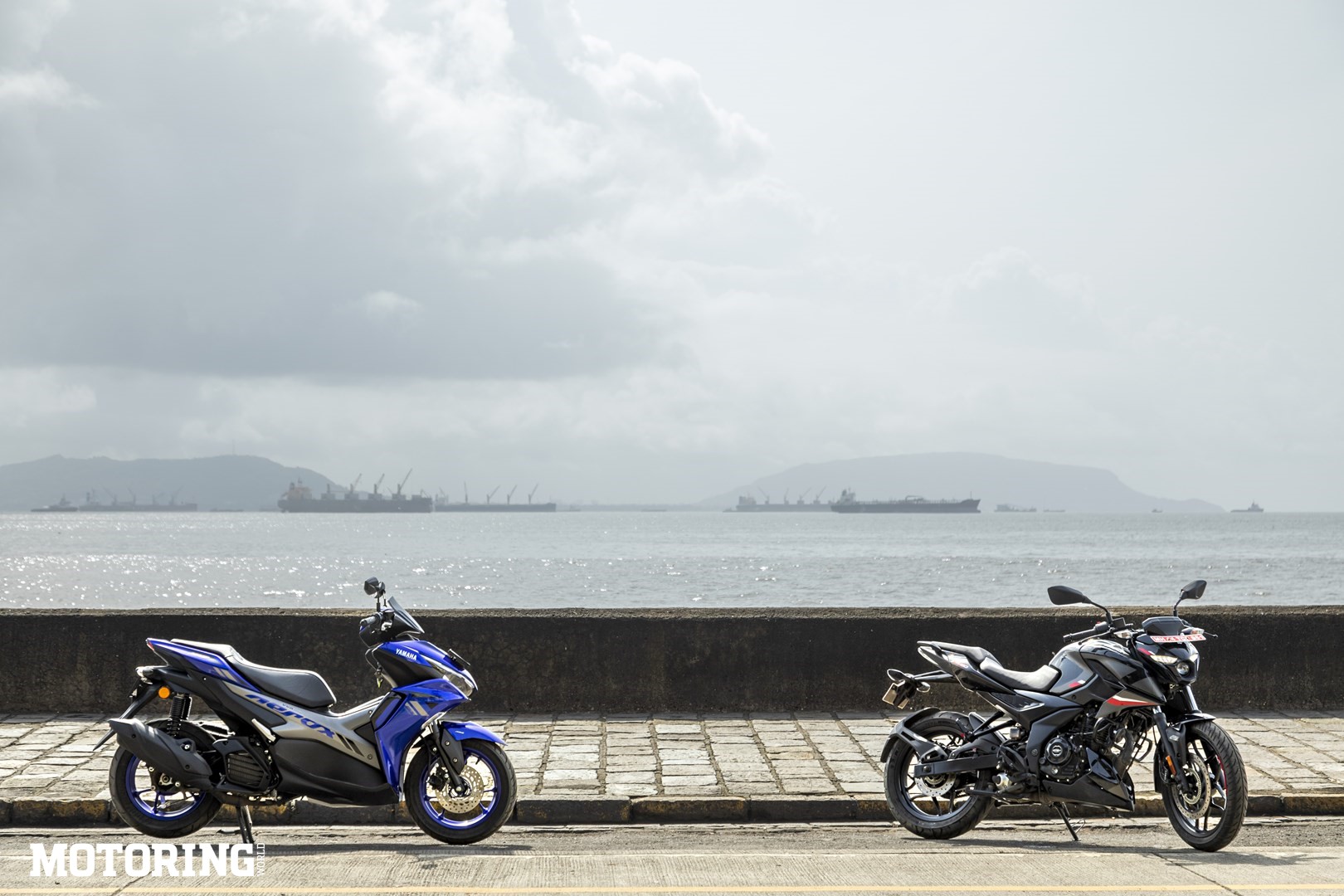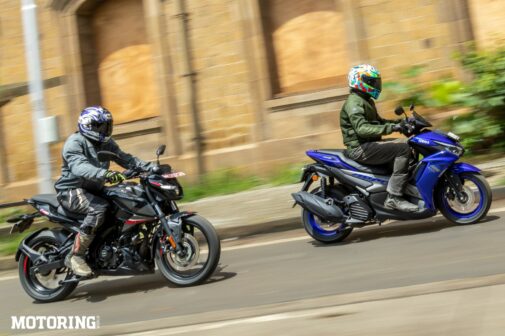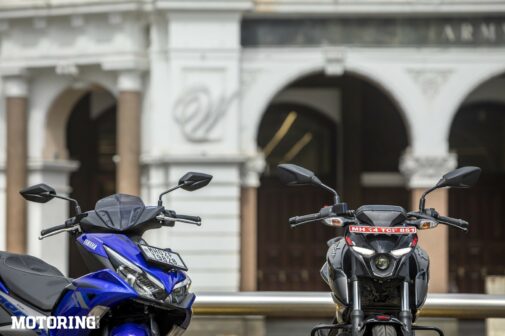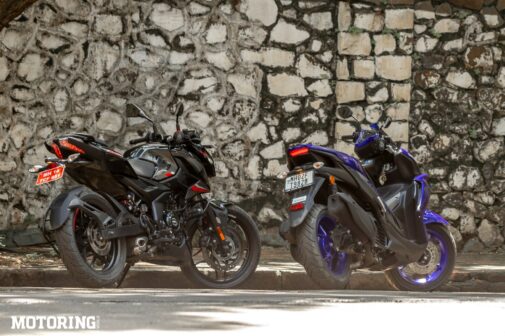So what are the in-things with kids these days? Is it even fashionable to say ‘in-things’ anymore? Anyway, a couple of decades ago I was at the end of the systematic war waged on young minds called education. I don’t remember exactly when it started, but as any traumatised person would, I developed a universal coping mechanism — sketching motorcycles on the back pages of my notebooks. Motorcycles only, mind you, never scooters. Scooters didn’t look right on bedroom walls, either, so those were again covered with motorcycle posters. Fast-forward to earlier today, I saw kids on scooters craning their necks to grab long eyefuls of the Yamaha Aerox, while the Bajaj Pulsar N160 was seemingly invisible to their immature eyes.
That was a bit of a bittersweet experience for me; as much as I love Yamahas, the Pulsar 180 was my first bike and I still have strong feelings for the name. Even if the new ones seem to have become invisible even to my own senescent eyes. However, once both the Aerox and the Pulsar were fired up, it was clear which one appealed to the ears the most. The N160’s deep hum makes it one of the recent bikes that believe in sounding good, its bigger siblings included. Indeed, it’d be perfect if the Aerox had the Pulsar’s vocal prowess to go with its racy looks. Instead, it’s like an MMA fighter’s stepped into the ring after a great lungful of helium.
Now, these machines are pretty close in most respects, as close as it gets between a motorcycle and a scooter. The Pulsar has 10cc and 1 bhp more than the Aerox; the difference in torque is a scant 0.09 kgm. However, the liquid-cooled Aerox is a whopping 28 kg lighter, while the Pulsar claws back an advantage by being cheaper at the showroom by Rs 12,000 while offering dual-channel ABS. And, of course, since scooters abandoned manual gearboxes a long time ago, the Aerox doesn’t demand anything from the rider’s legs except propping it up at rest. I’m still not sure if that’s a good thing or a bad thing, though I have to say the scooter remains fun to ride nonetheless.
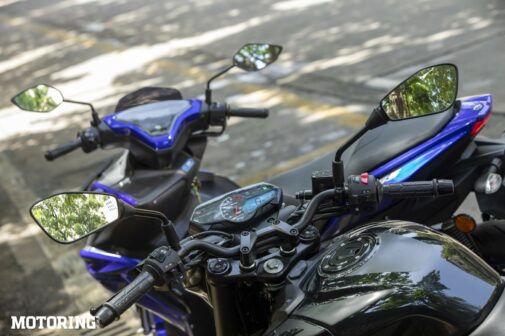
The Pulsar, on the other hand, retains the traditional involvement that a motorcycle is born with. Each hand and foot always has something to do, with every action focussed on extracting the most out of a smooth and sporty package. If increased activity is a measure, you’d think the Pulsar could keep degenerative brain diseases at bay longer than the Aerox, something recent generations seem to require more than previous ones. And while I’m not entirely sure of that prognosis, what’s beyond doubt is that the Aerox is a two-wheeled whetstone that sharpens the senses with every ride.
With the agility of smaller wheels combined with the stability of fat tyres, the Aerox makes full use of its R15-derived engine’s horsepower to become a traffic-thrashing corner-carving smile-shaping machine which I have difficulty calling a scooter. I mean, when did we ever have a scooter that was this much fun?! The Aerox takes the point-and-shoot method of riding to a whole new level. Even its brakes, which I think could have more bite, don’t get in the way. And the stock Ceat tyres on this particular Aerox betray no difference in performance to the first test unit’s IRC ones. The result is motorcycle-like handling and even better agility. All this with a huge boot to, er, boot.
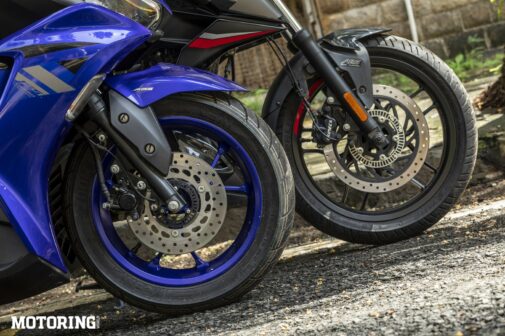
The Pulsar acquits itself rather well, too. The prompt bite of a clutch lever is not going to be beaten by a gummy CVT, so the N160 out-accelerates the Aerox from every traffic signal. With that said, the Pulsar’s slightly iffy gearshift action does make the Aerox’s twist-and-go nature seem all the more welcome. One misshift on the bike and the scooter blasts past without thinking twice. And in a full-throttle run between speed cameras, the Pulsar and the Aerox top out at 117 kph and 115 kph respectively. But both have the most fun between 50 kph and 100 kph, feeling as natural as a fun breeze.
However, I have to admit that the Pulsar is the more comfortable machine of the pair. Its bigger wheels and more accommodating suspension float over undulations that make the scooter feel like a somewhat-cushioned jackhammer. So if your bones aren’t as forgiving as they used to be, a motorcycle still is the way to go. On its own, the Aerox isn’t all that painful, though, and its robust build quality allows the rider to fly over rough patches without a worry. However, downshifting hard into a corner with the reassuring sound and feel of engine braking is a feeling too ingrained in my two-wheeled brain, and tipping the freewheeling scooter into a fast corner always places doubt at the apex, even though the Aerox’s thick midsection does transmit more feel through the legs than empty floorboards do. Carefree kids who are used to that uncertainty should have no problems, though.
Speaking of being carefree, the Aerox is also the more expensive of the two to run and maintain. It goes through its 5.5-litre tank at a rate of 33 kpl, making for a range of less than 200 km. The Pulsar, on the other hand, romps away from petrol pumps with 52 kpl, its 14-litre tank up for long hauls with a range of around 700 km. A motorcycle is always the better petrol-camel and it’s an advantage that cannot be taken lightly. The scooter can’t help but focus on short bursts, while the motorcycle can do its thing all day long. However, the point is moot if all you do is ride within city limits.
When it comes to looks, it’s clear that despite the Pulsar’s best attempts, the Aerox steals the show. Bajaj has somehow managed to make the N160 avant-garde in a conservative way; it has great proportions, stance and features, but it still seems to lack that je ne sais quoi. Only spies need this kind of obscurity to blend into their backgrounds, not one of the most sporty motorcycles around. The Pulsar looks even more nondescript next to the Aerox which looks like it was carved with the same blade that shapes Yamaha’s sport bikes. In a classroom somewhere, a kid is no doubt scribbling out its shape in the back of his/her notebook.
The choice between a motorcycle and a scooter has always been a no-brainer for me. Nonetheless, the Aerox is the closest a scooter has come to a motorcycle, which is why the one in these photos now lives in my garage surrounded by six motorcycles. As far as overall ability goes, the Pulsar is still the more accomplished one of the pair and you cannot go wrong with it. It’s just that the Aerox is better at being a scooter than the Pulsar is at being a motorcycle — but not by much. In this case, the scooter is the one that sets the heart singing, and that’s something hitherto inconceivable. I suppose that’s what a real in-thing does.
MOTODATA
Bajaj Pulsar N160POWERTRAIN
Displacement:
Max Power:
Max Torque:
Transmission:
165cc, single
15.8 bhp@8750 rpm
1.49 kgm@6500 rpm
5-speed
CHASSIS
Type: Tubular frame
BRAKES
F/R: 300-mm disc / 230-mm disc
TYRES
F/R: 100/80 R17 / 130/70 R17
DIMENSIONS
L/W/H (mm):
Wheelbase:
Ground Clearance:
Seat height:
Kerb Weight:
Fuel Capacity:
NA
1358 mm
165 mm
795 mm
154 kg
14 litres
PRICE
Rs 1.27 lakh (ex-showroom, Delhi)
MOTODATA
Yamaha Aerox 155POWERTRAIN
Displacement:
Max Power:
Max Torque:
Transmission:
155cc, single
14.8 bhp@8000 rpm
1.4 kgm@6500 rpm
CVT
CHASSIS
Type: Tubular steel frame
BRAKES
F/R: 230-mm disc / 130-mm drum
TYRES
F/R: 110/80 R14 / 140/70 R14
DIMENSIONS
L/W/H (mm):
Wheelbase:
Ground Clearance:
Seat height:
Kerb Weight:
Fuel Capacity:
1980/700/1150
1350 mm
145 mm
790 mm
126 kg
5.5 litres
PRICE
Rs 1.39 lakh (ex-showroom, Delhi)





